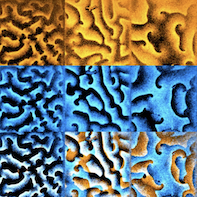How bulk-surface coupling affects protein patterns
Fridtjof Brauns, Grzegorz Pawlik, Jacob Halatek, Jacob Kerssemakers, Erwin Frey & Cees Dekker
 Self-organized spatiotemporal patterns are crucial for the function of organisms on all levels, from intracellular molecular organization to developing embryos. A central problem in understanding the formation of intracellular protein patterns is the coupling between the membrane surface and the cytosolic bulk. This bulk-surface coupling is a fundamental and general property of protein-based pattern formation, where proteins undergo attachment and detachment at the cell membrane. However, the consequences of this bulk-surface coupling remain poorly understood.
Self-organized spatiotemporal patterns are crucial for the function of organisms on all levels, from intracellular molecular organization to developing embryos. A central problem in understanding the formation of intracellular protein patterns is the coupling between the membrane surface and the cytosolic bulk. This bulk-surface coupling is a fundamental and general property of protein-based pattern formation, where proteins undergo attachment and detachment at the cell membrane. However, the consequences of this bulk-surface coupling remain poorly understood.
We have developed a systematic theoretical understanding of pattern formation in a concrete bulk-surface coupled system, namely the Min system of E. coli - a paradigmatic model system for studying biological pattern formation in vivo and in vitro. Our theoretical findings, in combination with experiments confirming the theoretical predictions, have allowed us to finally solve a long-standing puzzle, namely the qualitative differences between in vivo pole-to-pole oscillations and in vitro waves of Min proteins.
The central insight of our work is that bulk-surface coupling imparts a strong dependence of pattern formation on the geometry of the spatial confinement. Depending on this geometry, specifically the ratio of bulk volume to surface area, patterns emerge due to qualitatively different mechanisms from the same underlying biochemical interactions. We control the bulk-to-surface ratio in a minimal in vitro Min assay using laterally wide microchambers with a well-controlled bulk height, where we observe a striking variety of patterns for different chamber heights. Theoretical analysis of a minimal model qualitatively reproduces these patterns and shows that the patterns at low bulk height are driven by the same lateral oscillation mode that also underlies the pole-to-pole oscillation in vivo. At larger bulk heights, additional vertical oscillation modes set in. We predict and experimentally confirm the characteristic signatures in the patterns caused by these distinct oscillation modes.
Altogether, our results show that the bulk-surface ratio is the key control parameter that distinguishes the in vivo setting from the traditional in vitro setups. More generally, this shows that a principled theoretical framework makes it possible to gain deep mechanistic insights from in vitro reconstitution studies, even if the observed phenomena differ qualitatively and quantitatively from those observed in vivo.

